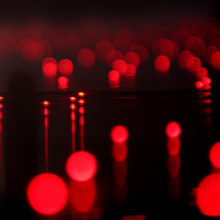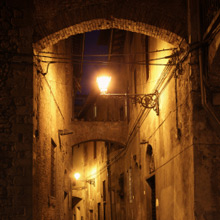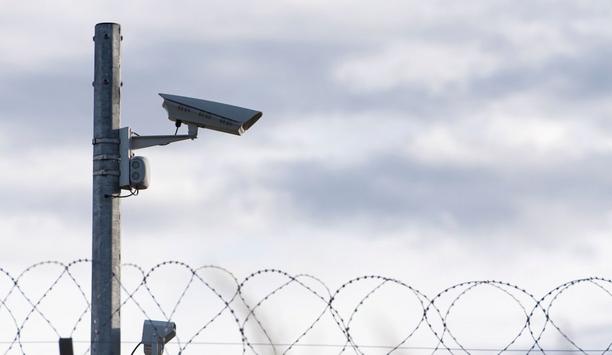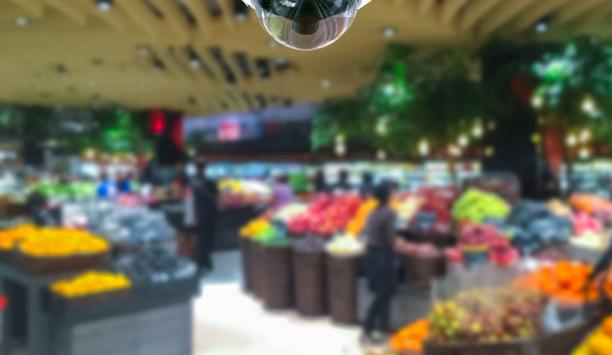 |
| Night-time surveillance has various challenges to overcome in terms of capturing high quality images |
Managing bandwidth in low light conditions
Whether analogue or digital (where encoding algorithms like H.264 encode analogue video for use with IP systems), virtually all CCTV cameras can capture good, useable images in bright, daytime conditions. However, it is how well your security system performs at night that determines its overall effectiveness, and since most crime takes place during the vulnerable hours of darkness, today's security systems need to be equipped for round-the-clock surveillance.
It is precisely at night that most criminals will try to take advantage of weaknesses in surveillance systems |
Improving image quality and usability is one obvious benefit of specifying security illumination. However, another key benefit for CCTV users is only now coming to light. When light levels drop there is a significant increase in the bit rate of the encoded video stream from each camera in a network. This increased bit rate, if left unaddressed, will cause a substantial increase in the total storage costs of the system.
Understanding automatic gain control (ACC) in night vision security cameras
To understand why low light surveillance has such a higher bandwidth requirement and transmits video at a higher bit rate, we need to consider automatic gain control (AGC).
AGC is camera technology, which increases signal strength in low light conditions. It works simply by amplifying the image; the effect of this amplification however is increased video signal and in turn increased image noise.
Take a typical security installation: on-site surveillance cameras deliver good, useable images during the day but as darkness approaches the cameras' AGC function kicks in. The darker it gets the more AGC increases in magnitude and the images the cameras capture become grainy and "noisy". Eventually the image is completely obscured by "snow" and becomes practically useless.
So why does "noisy" night-time surveillance video affect bit rate?
Impact of video compression algorithms
To understand why there is a rise in bit rate, it is important to have a basic understanding of how video compression algorithms work. The basic principle of compression is to eliminate all unessential information and reduce file size. All compression requires a compromise between image quality and file size. Higher compression ratios enable smaller file sizes but low quality images; lower compression ratios produce high quality images but need larger file sizes.
| |
| Problems of low light conditions can be greatly reduced or eliminated with the proper surveillance camera technology |
Today's most popular video compression engines incorporate JPEG, MPEG or M-JPEG. Most recent is the new H.264 algorithm that uses approximately 30% less bandwidth than MPEG4 compression technology, which is itself 80% more efficient than M-JPEG. All however share common reduction principles; irrelevancy reduction, which removes sections of the video signal not noticeable by the human eye (like subtle colour changes) or redundancy reduction which removes duplicated information from either the same frame or between frames, large block areas of colour or stationary objects for example.
Relationship between low light surveillance, compression and bit rate
At night there is generally less activity on scene and less movement in the cameras field of view, therefore night-time video should be able to be stored at a lower bit rate. However, image noise caused by increased camera gain can interfere with compression algorithms used by video encoders. To be precise, compression algorithms interpret noisy AGC enhanced images as movement on-scene and therefore useful information that cannot be reduced in size by irrelevancy or redundancy. Because of this night-time surveillance video is less compressed and larger in file size than it should be. It is now clear that there is a direct relationship between low light surveillance, compression and bit rate.
The effect of bit rate on cost of a security system
Increasing storage space is a costly exercise and one of the principal expenses of a modern digital security system |
The benefits of combining infrared and encoding (IP and Hybrid)
Rather than continually adding storage to a security system it is best to address the root cause of the problem - high bit rate at night. At first it seems a quick fix would be to simply disable the cameras' AGC function. While this would reduce bit rate, it would be at the expense of all important image detail. Disabling the cameras' AGC function would result in poor quality, if not useless, surveillance images. A better solution is to install energy efficient infrared illumination on scene. When used with infrared, high camera gain becomes unnecessary and compression algorithms in encoders, DVR's and other recording equipment work to optimum effect.
Using infrared illumination enables security cameras to deliver high resolution, evidentiary quality night-time surveillance video with virtually zero image noise, and as we now know, less video noise equals better compression, reduced bit rate and reduced storage requirements.
 |
| Using infrared illumination enables security cameras to deliver high resolution night-time surveillance video |
At the most basic level, infrared is light. Light that is invisible to the human eye but which is used by monochrome and dual mode surveillance cameras to reveal night-time scenes which would appear completely dark to the human eye - remember our golden rule, without light there can be no picture.
Infrared prevents noisy night-time images and the subsequent chain of events that causes high bit rates, excessive storage requirements and unnecessary expense. In addition, certain infrared illuminators feature innovative 3D diffuser (Black Diamond) technology which directs light to the foreground and background of the cameras field of view, for perfectly evenly illuminated night-time images, free from hotspots and overexposure caused by some other IR illuminators. Remember the higher the quality of the image, the lower the storage requirement and overall cost of the system.
Using IR to reduce storage needs in digital video applications
Although the use of infrared lighting to improve image quality and usability is widely understood by the security industry, its use as a bandwidth management tool may come as a surprise. Given that storage is one of the biggest expenses incurred when operating a security system, that surprise is a welcome one and should encourage the use of IR as an effective tool for reducing storage needs in digital video applications.
 | Ian Crosby EMEA Product Marketing Manager - Illumination Bosch Security Systems |




















